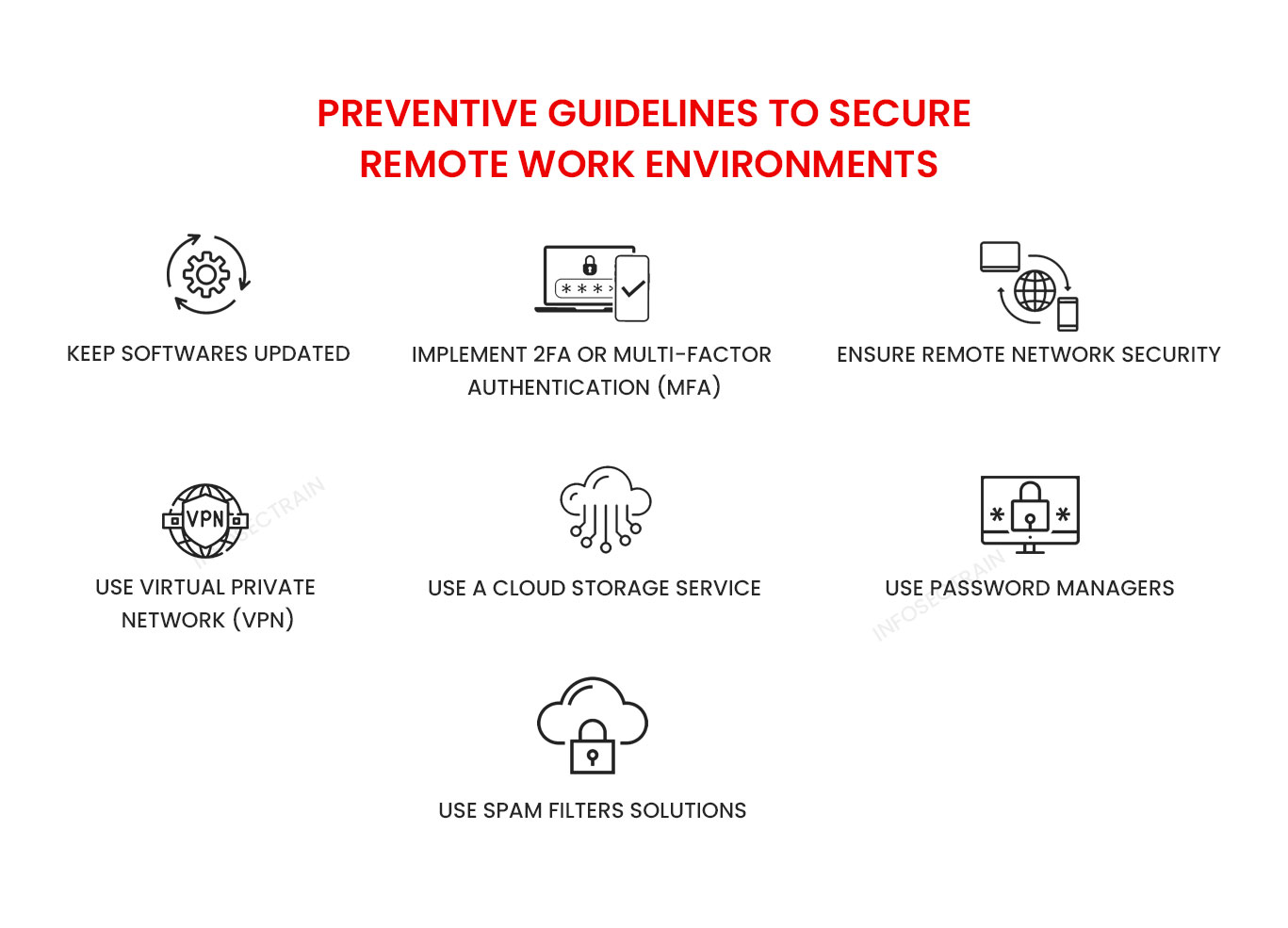How to Secure a Remote Working Environment?

Most employees transitioned to working remotely when the world stopped down due to COVID-19. And now everyone is demanding remote work as a part of their working lives. In remote work, a user can access sensitive company data outside the workplace and do business from any place. However, remote working can also increase the risk of fraud, data misuse, and cybercrime, which could be dangerous for user’s personal and professional security. Also, the remote work trend can affect the overall security measures of many firms. Therefore, users need to secure remote access by implementing some security majors to avoid these things. This blog will cover how we can secure a remote work environment.
Security considerations for remote users
Here are some preventive guidelines we will advise you to implement while working remotely:

1. Keep softwares updated
Cybercriminals can take advantage of vulnerabilities or security holes in outdated softwares. Therefore, software updates are necessary for digital security and cybersecurity. Software updates typically include significant security fixes addressing system vulnerabilities and security loopholes. Software updates also include new or improved features. They remove outdated features and improve the stability of your softwares.
2. Implement 2FA or Multi-Factor Authentication (MFA)
Today, single-factor authentication is insufficient to keep hackers out of your applications, digital accounts, and other things because they can easily obtain your username and passwords. Therefore, implement the 2FA or Multi-Factor Authentication method, which provides two or more verification factors such as a passcode, token, or certificate for access to any of the resources necessary to safeguard your essential applications, accounts, and data. In this method, passwords are not enough to obtain access to the applications and accounts; the hackers need multiple forms of verifications.
3. Ensure remote network security
For remote users, it is crucial to employ secure Wi-Fi networks to safeguard their activities. Therefore, they must encrypt the network by upgrading the router’s settings to WPA2 Personal or WPA3 Personal. And change the router’s default password to something more complicated and unique to prevent hackers from accessing your network. Additionally, make the router admin password more complex and secure because this is the main access point from which hackers can access the network’s admin side and change the Wi-Fi network password.
4. Use Virtual Private Network (VPN)
Many remote users connect through unsecured Wi-Fi or other unreliable network connections, which is not secure for the data’s privacy. Therefore, employ a Virtual Private Network (VPN) whenever you use a public network; it creates a secure connection between devices and networks and ensures the safe transmission of sensitive information. It encrypts your network traffic and protects your IP address from hackers. It enables the user to work remotely and prevents unauthorized individuals from monitoring the network traffic.
5. Use a cloud storage service
A reliable cloud storage solution is now more crucial than ever because of remote work. Cloud storage services, such as Google Drive, iDrive, pCloud, OneDrive, etc., are the most straightforward and efficient approach to storing and securing your data when working remotely. You can access your files and folders anytime from any place by storing them in the cloud and creating backups for your private files. In order to stop unauthorized access to your data, it encrypts all of your data.
6. Use password managers
Most users use weak passwords that are easy for hackers to crack and reuse the same passwords across several applications and websites because they have difficulty remembering passwords. Therefore, there are apps for users, Password Managers, which are encrypted password applications that ensure password security. Password Manager apps automatically create highly secured new and unique, random passwords for every website or app the user visits and keep track of user login details. So users won’t have to remember every password. Some of the popular password managers apps include:
- LastPass
- Keeper
- Sticky Password
- LogMeOnce
- 1Password
- Zoho Vault
- Password Boss
7. Use spam filters solutions
Spam is an unsolicited email with malicious links that hackers may send with malicious intentions. It is crucial to prevent spam emails to protect your network against several risks, including phishing emails, malware, spyware, and other malicious content. Therefore, use an efficient spam filtering solution to protect your inboxes from unsolicited and spam emails. You won’t have to waste time manually sorting through spam emails because it blocks all of them before they even get to your inbox. They can separate secure emails from spam and block threats like viruses and phishing attacks. Some of the best spam filters include:
- Topsec Email Security
- MailChannels
- MailWasher
- SpamTitan
- Symantec Email Security
- Spambrella
How can InfosecTrain help you?
You can enroll in InfosecTrain’s Cyber Security Orientation Program training course if you think managing the greater security level for you and your company under the cybersecurity risk will be challenging. We will help you to develop the advanced skills necessary in the cybersecurity domain. With InfosecTrain, you will also get several advantages, including a flexible training schedule, practical experience in our lab sessions, a certificate of participation, etc.




 1800-843-7890 (India)
1800-843-7890 (India) 
